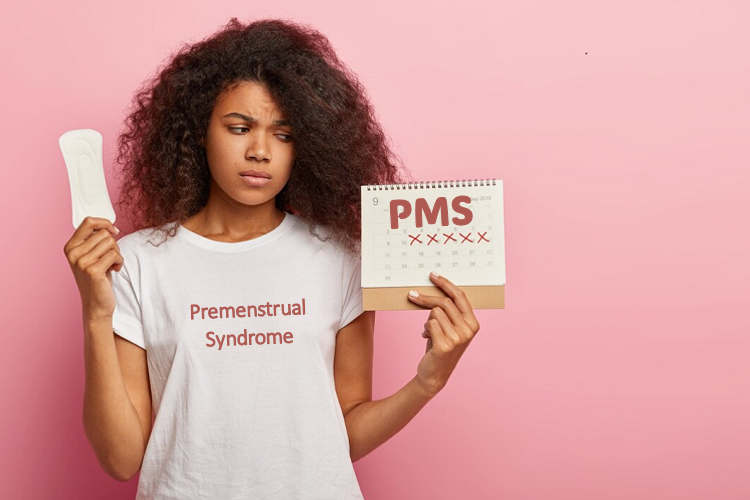Premenstrual Syndrome (PMS) is like the monthly subscription you never signed up for but arrives punctually, bringing a mixed bag of physical and emotional surprises. While the intensity and symptoms vary widely among women, the quest for effective management strategies unites us all. PMS turns women into emotional, bloated, and irritable monsters. Here are some revolutionary ways to ease those pesky PMS symptoms.

6 Ways to Ease PMS Symptoms
PMS is a common condition for women with physical and emotional symptoms. Coping with it can be tough, but there are smart ways to make it easier. To reduce PMS symptoms, try these strategies until your period starts and your hormones improve.
1. Dietary Do’s and Don’ts
Believe it or not, your diet plays a starring role in the PMS drama. Incorporating whole foods, rich in vitamins and minerals, can act as your shield against the onslaught of cramps and mood swings. Think leafy greens, nuts, and seeds, which are high in magnesium and B vitamins, offering a natural remedy to soothe those PMS blues.
On the flip side, it’s wise to reduce the intake of salt, caffeine, and sugar to prevent bloating and fatigue from taking center stage. Hydration is your best friend here, so keep that water bottle close. By choosing your meals wisely, you’re not just feeding your body but fortifying your defenses against the PMS tide.
2. Lean on Your Squad
Never underestimate the power of your support network during the PMS phase of your cycle. Whether it’s family, friends, or a dedicated support group, being able to share your experiences and feelings can provide emotional relief and a sense of belonging.
Sometimes, just knowing you’re not alone in your PMS journey can make all the difference. Furthermore, your support network can offer practical help, like reminding you to stick to your health routine or joining you in stress-relieving activities. Emotional support combined with practical assistance can significantly lighten the PMS burden.
3. Exercise Your Way to Relief

While the idea of working out might not seem appealing when you’re in the grips of PMS, moving your body is a secret weapon worth wielding. Exercise releases endorphins, those feel-good hormones that can dance away the pain and lift your spirits. Whether it’s a brisk walk, a yoga session, or a dance-off in your living room, finding an activity that brings you joy is key.
It’s not about intensity; it’s about consistency and enjoyment. This is the perfect opportunity to craft a daily health routine that incorporates physical activity tailored to your preferences and schedule. Embracing movement can transform your PMS experience from daunting to manageable, with the added bonus of boosting your overall health and mood.
4. Hormone Balance Supplements
While diet and exercise lay the groundwork for alleviating symptoms, sometimes, your body craves an extra layer of support. This is where a hormone balancing supplement steps into the limelight. These supplements are designed to do exactly what their name suggests – balance hormones. They can be particularly effective for those who experience severe PMS symptoms that diet and lifestyle adjustments alone can’t tame.
Hormone balance supplements work by targeting the root cause of PMS symptoms: hormonal fluctuations. By providing your body with the nutrients it needs to maintain hormonal equilibrium, these supplements can significantly ease PMS symptoms like mood swings, bloating, and irritability. It’s important to choose a supplement backed by science that fits your specific needs, as each woman’s hormonal blueprint is unique.
5. Stress Management
Stress is a well-known trigger that can amplify PMS symptoms, making it crucial to have stress-busting strategies up your sleeve. Mindfulness practices such as meditation, deep breathing exercises, and yoga are not just buzzwords but powerful tools for maintaining emotional equilibrium.
Dedicating even a few minutes a day to these practices can significantly lower stress levels, thus mitigating the severity of PMS symptoms. Establishing a relaxation routine before bed, like reading or a warm bath, can also enhance your sleep quality, reducing stress and its impact on PMS.
Remember, managing stress is not a one-size-fits-all approach, so experiment with different techniques to discover what best helps you unwind and recharge.
6. Sleeping Habit

Never underestimate the power of a good night’s sleep, especially when it comes to combating PMS. Sleep affects our hormonal balance, mood, and overall health, making it a cornerstone of effective PMS management.
Aim for 7-9 hours of quality sleep per night by establishing a consistent sleep schedule and creating a sleep-conducive environment. This means limiting screen time before bed, ensuring your bedroom is cool and dark, and possibly incorporating calming activities like gentle stretching or listening to soothing music.
By prioritizing sleep, you’re giving your body the rest it needs to navigate the hormonal changes of your menstrual cycle with grace.
Conclusion
PMS might feel like a formidable foe, but armed with the right strategies, you can transform your experience into something much more manageable, even positive. Each of these ways offers a piece of the puzzle to managing PMS symptoms with ease, they can help you ride the wave of your menstrual cycle with ease and confidence.


